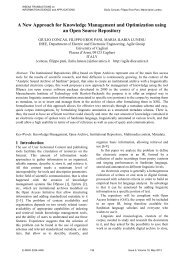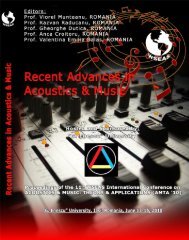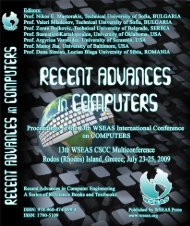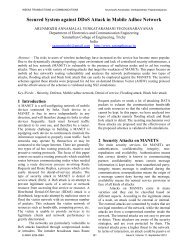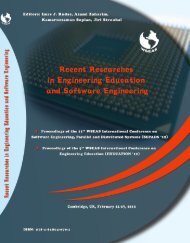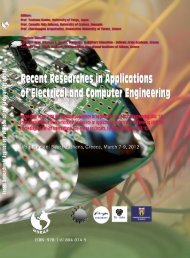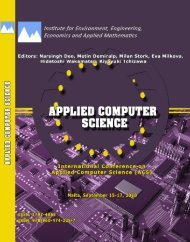Contents of this book - WSEAS
Contents of this book - WSEAS
Contents of this book - WSEAS
You also want an ePaper? Increase the reach of your titles
YUMPU automatically turns print PDFs into web optimized ePapers that Google loves.
Mathematical Methods for Information Science and Economics<br />
Keynote Lecture 1<br />
Kronecker Power Series in Quantum Mechanical Probabilistic Evolution Approach:<br />
Managing Arbitrariness in Spectral Issues <strong>of</strong> the Propagation Superoperator<br />
Pr<strong>of</strong>essor Metin Demiralp<br />
Resigned Principal Member <strong>of</strong> Turkish Academy <strong>of</strong> Sciences<br />
Istanbul Technical University<br />
Informatics Institute Istanbul<br />
TURKEY<br />
E-mail: metin.demiralp@gmail.com<br />
Abstract: Recently we have started to use Kronecker power series instead <strong>of</strong> the multivariate Taylor series, in the<br />
formulation <strong>of</strong> the “Probabilistic Evolution Approach (PEA)” to ODEs, Quantum Expectation Value Dynamics, and,<br />
Classical Statistical Mechanics within the perspective <strong>of</strong> Liouville equation, density and partition functions. The basic<br />
idea has been to expand the unknown entities in terms <strong>of</strong> Kronecker powers <strong>of</strong> a vector describing the system under<br />
consideration. This system vector is either composed <strong>of</strong> the temporally varying unknowns in the case <strong>of</strong> ODEs or<br />
certain operators’ expectation values varying in time for the other cases. The Kronecker powers <strong>of</strong> the state vector (or<br />
their expec tation values in the case <strong>of</strong> Quantum Mechanics or Classical Statistical Mechanics) have been considered<br />
as the basis set elements and certain ODEs for each <strong>of</strong> them have been constructed. The result in all cases (for<br />
ODEs, Quantum Expectation Values, Statistical Mechanical Expectation Values) was a first order linear<br />
homogeneous infinite vector ODE with generally initial value impositions, such that the coefficient matrix (we call<br />
“Evolution Matrix) for <strong>this</strong> infinite explicit vector ODE was a constant infinite square matrix. The formal analytical<br />
solution <strong>of</strong> <strong>this</strong> infinite vector ODE can be obtained and requires the evaluation <strong>of</strong> an exponential matrix varying in<br />
time whose proportionality coefficient is the Evolution Matrix. This evaluation is facilitated when the evolution matrix<br />
(which is in upper block Hessenberg form most generally) becomes block triangular because <strong>of</strong> certain limitations in<br />
the system. Triangularity makes the spectral analyses quite simple. Beyond that, the case <strong>of</strong> multinomiality where the<br />
Evolution Matrix has the main diagonal and its few upper neighbor diagonals as the nonvanishing substructures,<br />
enables to use the finite order block recursions to get solution to PEA equations.<br />
The case <strong>of</strong> conicality is the simplest form <strong>of</strong> the multinomiality and corresponds to two term block recursions whose<br />
solutions can be analytically constructed as infinite series <strong>of</strong> the initial values <strong>of</strong> the Kronecker powers <strong>of</strong> the state<br />
vector or its expectation values. In fact all multinomial cases can be converted to two term block recursions via<br />
appropriate order reductive manipulations.<br />
What we have told above is somehow the review <strong>of</strong> the last year developments <strong>of</strong> the “Probabilistic Evolution Theory”<br />
and it will be kept sufficiently comprehensive but, at the same time, sufficiently short during the presentation. The<br />
remaining part is completely new and based on recently developed issues. The Kronecker powers <strong>of</strong> the state<br />
vector(s) contain certain number <strong>of</strong> identicalities or linear dependences as the price <strong>of</strong> the brevity in the relevant<br />
multivariate representation. These can be in fact reflected to the Kronecker power series coefficients as certain level<br />
<strong>of</strong> arbitrarinesses. These arbitrarinesses can be expressed in terms <strong>of</strong> certain flexible parameters which can be<br />
determined as what we want to obtain, <strong>of</strong> course, within certain limitations.<br />
A special emphasis will be given on the commutator algebra over the state vector’s Kronecker powers. The<br />
propagation superoperator acting on an operator to give the time variant exponential function image <strong>of</strong> the operator’s<br />
commutator with the Hamiltonian. The construction <strong>of</strong> certain eigenoperators <strong>of</strong> the propagation superoperator will be<br />
explained in the perspective <strong>of</strong> the Kronecker power series and the management <strong>of</strong> the arbitrariness appearing there.<br />
Brief Biography <strong>of</strong> the Speaker: Metin Demiralp was born in T¨urkiye (Turkey) on 4 May 1948. His education from<br />
elementary school to university was entirely in Turkey. He got his BS, MS degrees and PhD from the same institution,<br />
ÿIstanbul Technical University. He was originally chemical engineer, however, through theoretical chemistry, applied<br />
mathematics, and computational science years he was mostly working on methodology for computational sciences<br />
and he is continuing to do so. He has a group (Group for Science and Methods <strong>of</strong> Computing) in Informatics Institute<br />
<strong>of</strong> ÿIstanbul Technical University (he is the founder <strong>of</strong> <strong>this</strong> institute). He collaborated with the Pr<strong>of</strong>. Herschel A.<br />
Rabitz’s group at Princeton University (NJ, USA) at summer and winter semester breaks during the period 1985–<br />
2003 after his 14 month long postdoctoral visit to the same group in 1979–1980. He was also (and still is) in<br />
ISBN: 978-1-61804-148-7 12




